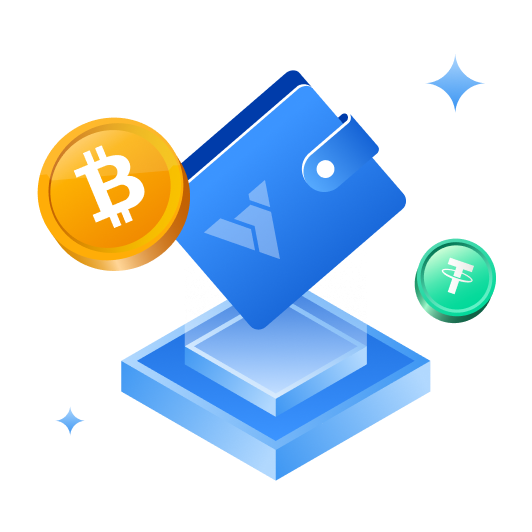五个步骤即可于 BYDFi 购买
免费开立 BYDFi 账户
使用您的邮箱/手机号码和居住国家/地区注册 BYDFi,并创建一个強密码來保护您的账户
保护您的账户安全
请启用谷歌身份验证(2FA),设置防钓鱼码,交易密码,为您的账户多加一层保护
验证账户
您可通过输入个人信息和上载有效身份证的照片来验证您的个人身份
添加付款方式
你的 BYDFi 帐户验证后,请新增信用卡/借记卡或银行帐户
Buy
可选用多种付款方式于 BYDFi 购买KSM。我们将引导你进行操作
选择于 BYDFi 购买 KSM 的方式
于BYDFi购买加密货币非常简单方便。来探索如何以不同方式购买
- 1
使用信用卡或借记卡购买
这是新用户最简单购买(KSM)的方式。 将您的信用卡或借记卡连接到您的账户,输入购买金额,然后等待交易完成
- 2
透过第三方渠道购买
BYDFi 支持各种领先的第三方支付处理器。 访问我们的第三方支付頁面查看您所在地区可用的支付方法
- 3
在 BYDFi 现货市场用加密货币购买
BYDFi 现货市场支援 700 多种数码资产,是购买最受欢迎的平台。购买方法如下:1. 通过 BYDFi 的快捷买币通道、P2P 及第三方买家购买稳定币。或者,您也可将其他钱包或交易平台的加密资产转移到 BYDFi 平台。请确保选择正确的区块链网络,一旦将加密资产储存到错误地址将无法逆转2. 将你的加密货币转到 BYDFi 交易帐户。 在 BYDFi 现货市场寻找希望交易的的交易对。下单将你现有的加密货币兑换为提示:BYDFi 提供多种订单类型在现货市场购买,例如即时购买的市场订单和以指定价格购买加密货币的限价订单。 有关 BYDFi 订单类型的更多信息,请点击此处
3. 订单一旦执行成功,即可在交易帐户中查看可用的
如何存储
储存 的最佳方式因您的需要和偏好而异。 查看优缺点以找到储存 的最佳方法
将KSM存储在你的 BYDFi 账户中
在您的 BYDFi 账户中持有您的加密货币可以快速访问交易产品,例如现货和合约交易、质押、借贷等。 BYDFi 作为您加密资产的托管人,帮助您免去自行保管私钥的麻烦。 确保设置强密码并升级您的安全设置,以防止恶意行为者获取您的资金
将你的KSM存放在非托管钱包
「无匙即无币,币匙为一体」如果安全是您最关心的问题,您可以将您的 提取到非托管钱包。 将 储存在非托管或自托管钱包中可让您完全控制您的私钥。 您可以使用任何类型的钱包,包括硬件钱包、Web3钱包或纸质钱包。 请注意,如果您希望频繁交易您的 或使用您的资产,此选项可能不太方便。 请务必将您的私钥储存在安全位置,因为丢失它们可能会导致您的 永久丢失
你于 BYDFi 可以如何使用
持有
在你的BYDFi帐户中储存。
Trade
在现货市场和期货市场中交易。

为何 BYDFi 是购买 的最佳平台?
安全可靠
我们的常规储备证明 (PoR) 机制确保客户资金得到 1:1 实物资产的支持。 BYDFi 被福布斯评2021 年最佳加密货币交易所之一,并被 Ascent评为 2022 年最佳加密货币应用程式
高流动性
BYDFi 针对所有已上市的加密货币拥有高流动性的买卖订单,可提供点差较小的流动性交易体验
加密货币 Gem 之家
BYDFi 支援 700 多种加密货币,是寻找下一个加密货币 Gem 的最佳平台。于 BYDFi 可购买到KSM以及使用其兑换各种数码资产
介面简便
由于我们的介面简便、技术强劲,于 BYDFi 购买快捷方便。于 BYDFi 买币即可获得KSM
Trade
问答
What Is Kusama (KSM)?
Self-described as "Polkadot's wild cousin," Kusama is an experimental blockchain platform that is designed to provide a massively interoperable and scalable framework for developers.
Kusama is built on Substrate — a blockchain building kit developed by Parity Technologies. Kusama has almost the same codebase as Polkadot — one of the most successful interoperable blockchains.
By deploying on Kusama, fast-paced projects gain access to a highly scalable, interoperable sharded network, with features that are not yet available on Polkadot. To that end, Kusama describes itself as a canary network.
The platform is designed to provide a testbed for developers looking to innovate and deploy their own blockchain and can be used as a preparatory network before launching on Polkadot — though many projects opt to stick with Kusama for their final product.
Kusama benefits from a low barrier to entry for deploying parachains, low bond requirements for validators, and is most commonly used by early-stage startups and for experimentation.
Who Are the Founders of Kusama?
Kusama was built by the same team that created Polkadot, a company known as Parity Technologies. Its founder is Dr. Gavin Wood, a world-renowned computer scientist and programmer, who also co-founded Ethereum.
Parity Technologies has an extensive team comprised of some of the world's most successful blockchain engineers, and has over 100 employees in total spread throughout the world.
In addition, Kusama is funded by grants from the Web3 Foundation, which was launched to help "nurture and steward technologies and applications in the fields of decentralised web software protocols." The Web3 foundation also supports Kusama with research and community development thanks to its growth team.
What Makes Kusama Unique?
Kusama is unusual among blockchain platforms since it is predominantly built for developers that want to launch bold, ambitious projects, with a fast-evolving pace of development.
It is built on a multichain, heterogeneously-sharded design that uses a nominated proof-of-stake (NPoS) consensus system — an alternative consensus mechanism to the energy intensive proof-of-work (POW) scheme employed by several other blockchains.
This system enables it to perform rapid on-chain upgrades without a fork, and support cross-chain message passing (XCMP) to enable communication with other parachains on the Kusama network.
Like Polkadot, Kusama features on-chain governance capabilities. This on-chain governance is both decentralized and permission-less, allowing anybody with Kusama (KSM) tokens or parachain tokens to vote on their respective governance proposals, which might include putative upgrades, changes to the protocol, and feature requests. This on-chain governance procedure is roughly four times faster than that offered by Polkadot, with a combined voting and enactment period of just 15 days — leading to the rapid pace of development for projects built on Kusama.
The project serves projects that want to hit the ground running, launching updates and improvements without the need to implement a fork to do so — thereby ensuring maximum community cohesion.
How Many Kusama (KSM) Coins Are There in Circulation?
As of November 2020, Kusama has a circulating supply of 8.47 million tokens, and a total supply of 10 million tokens. Unlike some other blockchains, this maximum supply is not fixed. Instead, it increases at an inflation rate of 10% per year.
The proportion of KSM that are staked changes how the newly minted KSM tokens (from inflation) are distributed. If exactly half of all KSM are staked, then Kusama validators receive 100% of newly minted tokens, whereas if it is above or below 50%, then some of the inflation rewards will go to the Kusama Treasury.
Kusama initially launched as an airdrop to those that participated in Polkadot (DOT) token sale. These were distributed at a 1:1 rate, while those without DOT were able to obtain KSM by using a frictional faucet — this has since been decommissioned. Unlike Polkadot, Kusama has not undergone redenomination to increase its circulating supply.
How Is the Kusama Network Secured?
Kusama is built using a nominated proof-of-stake (NPoS) consensus mechanism.
This uses a network of nominators (KSM stakers) who elect nodes to participate in the transaction validation process. These nominators receive a fraction of the inflation reward if their nominator is selected on the next rotation. Validators that act dishonestly or don't meet performance requirements can have their stake slashed.
Additionally, Kusama uses a simple queuing mechanism based on Merkle trees to resolve cross-chain transactions. Relay chain validators are responsible for moving transactions from the output queue of one parachain to the input queue of the target parachain — this is a secure, trustless process that uses the same validators on each chain to pass the messages.
Where Can You Buy Kusama (KSM)?
Kusama (KSM) is currently available to trade on dozens of popular exchange platforms, including Binance, OKEx and Huobi Global. The most liquid trade pairs for KSM are currently KSM/USDT, KSM/BTC and KSM/ETH.
To learn more about buying cryptocurrencies with fiat, see our comprehensive guide.
